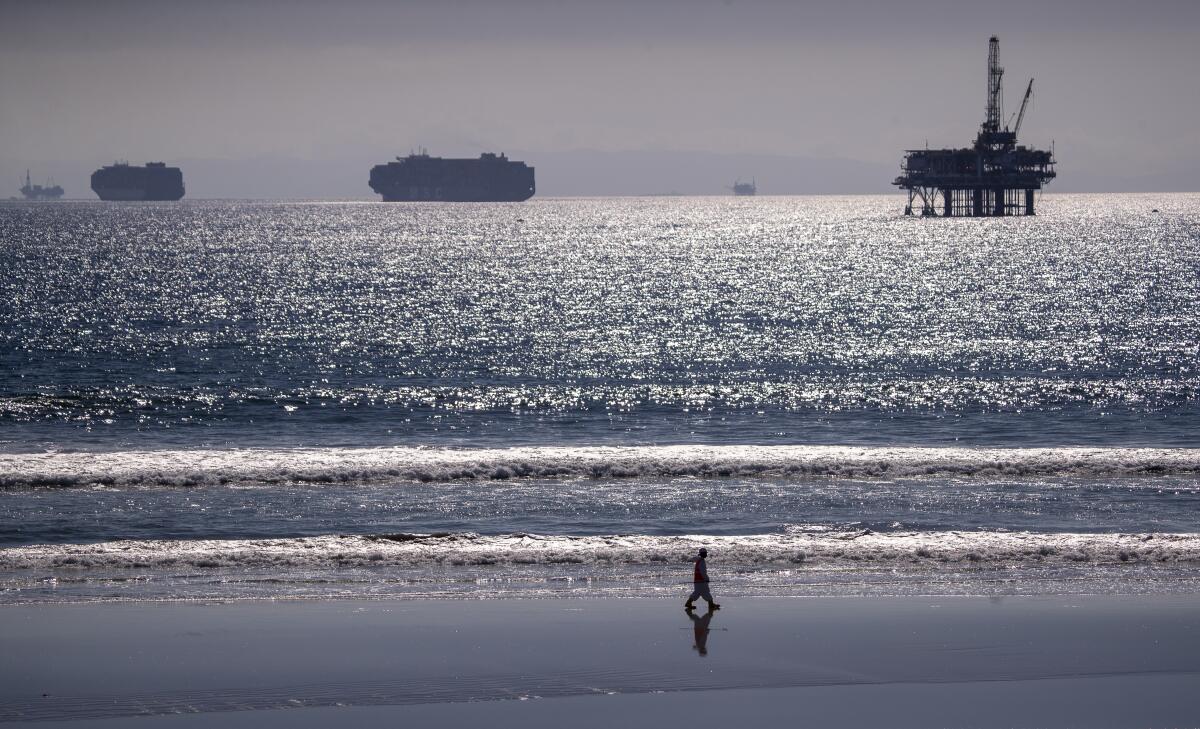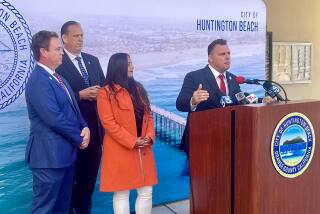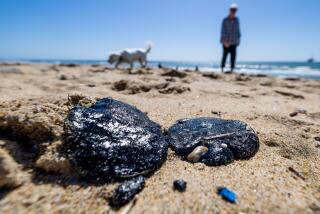A long road ahead to recovery from Huntington Beach oil spill

An oil sheen spotted off Huntington Beach this weekend served as a potent reminder of how long it will take Southern California to untangle the legal, regulatory and environmental fallout of an October pipeline spill that released an estimated 25,000 gallons of crude into the ocean.
A sheen 70 feet by 30 feet was spotted Saturday morning and gone by nightfall, authorities said. The U.S. Coast Guard said it was probably a residual leak from the ruptured 17.3-mile pipeline, which has been shut down since Oct. 2.
Divers preparing for a routine inspection of the damaged pipeline spotted the sheen about 9:30 a.m. Saturday, the California Department of Fish and Wildlife said. Underwater, they saw oil droplets near the damaged section, which since the spill has been encased in a material called Syntho-Glass. Divers removed the wrap and installed a new one.
If Amplify Energy, the Texas-based company that operated the pipeline, was responsible for the weekendâs release of the oil, there may be repercussions, said Ted Borrego, an oil and gas lawyer with 50 years of experience in the industry and adjunct professor at the University of Houston Law Center.
âIf it is a repeat problem which is caused by a company, then fines are in order,â Borrego said in an email, adding that authorities could take other steps depending on the circumstances.
Meanwhile, the wave of lawsuits sparked by the October spill is continuing to grind through the federal court system. Amplify is now facing 14 lawsuits filed by businesses, residents, property owners and others affected by the spill. The plaintiffs include Laguna Beach coastal property owners, a Huntington Beach surf school, a Seal Beach bait and tackle store, and several groups of fishing and seafood sales companies.
Several of the 22 law firms involved in the litigation have already pressed U.S. District Judge David O. Carter to consolidate their lawsuits into a class-action case. He signaled in a Nov. 9 court filing that he will eventually consolidate the cases, but is still weighing when to do so.
Carter has ordered a mid-December hearing at the Santa Ana federal courthouse, where lawyers could lobby to head up the litigation. He said he would lean toward selecting one or more firms with âlong-standingâ connections to Orange County and Los Angeles, experience with class-action litigation, and knowledge of bankruptcy and environmental law.
Asked for comment Monday, Amy Conway, a spokeswoman for Amplify, provided a link to a statement by the unified command that was established in response to the spill.
In court filings last month, an Amplify attorney identified a long list of insurers, including a Houston-based underwriter and 10 syndicates of Lloydâs, that could also shoulder some legal bills or eventual settlement costs.
Federal investigators believe the major October spill was triggered by a shipâs anchor striking the pipeline during a storm in January, complicating the question of civil liability for the incident.
Last week, federal authorities identified and boarded a second cargo ship, the container vessel Beijing, at the port in Long Beach. The Coast Guard said in a statement that the ship was involved in the Jan. 25 anchor-dragging incident during heavy weather at the ports of Los Angeles and Long Beach, and has designated the shipâs owners, Capetanissa of Liberia and the operator V-Ships Greece Ltd., as parties of interest in the investigation.
The October spill had a significant negative impact on the natural environment, despite the fact that the estimated amount of oil released was about one-fifth of what was initially reported. The UC Davis Oiled Wildlife Care Network said earlier this month that it had recovered 82 dead birds, six dead mammals, and dozens of living mammals in the aftermath of the spill. The dead animals included a bottlenose dolphin, three California sea lions and a wide array of birds: cormorants, coots, pigeons, grebes and more.
The USC Sea Grant Program reported that 5,544 gallons of oil, 13.6 barrels of tar balls and 546,782 pounds of âoil sand and debrisâ had been collected from the Southern California coast as of Nov. 8. Area fisheries remain closed, but the beaches have reopened and the USC program reported that an analysis found that âSan Diego and Orange County air, water, and sediment do not pose a public health concern for short-term exposures from the use of the water and beaches in the counties.â
Last week, Amplify withdrew its full-year report, citing the spill as a factor in the decision. In a filing with the U.S. Securities and Exchange Commission, the company said that it âpaid approximately $17.3 million in costs related to remediation efforts regarding the Incident,â most of which has been or is expected to be reimbursed by insurance carriers.
Stephen Schork, a longtime energy markets analyst and advisor, said he worries that rapid divestment from fossil fuel infrastructure like Southern Californiaâs aging platforms has increased the likelihood of oil spills by smaller operators like Amplify, which donât have the resources international energy conglomerates have to prevent such incidents and compensate affected communities once they occur.
âIâm fearful you can expect more of these instances in the years ahead with greater frequency with the way weâre going with our investments,â he said.
Eric Smith, a business professor at Tulane University in New Orleans and associate director of the Tulane Energy Institute, said he believes the government has little remaining recourse with Amplify.
âI donât think there is much more that the authorities can do to Amplify,â he said. âGiven the financial overhang, they are a zombie at this point.â
But Schork said itâs still imperative for the company to do everything it can to prevent future incidents, and for regulators to oversee those efforts.
âItâs absolutely in the best interest of every producer out there to be as meticulous as possible, and itâs incumbent on the regulators to ensure that that is happening,â he said. âTheyâre making sure this issue is being addressed and a remedy is being implemented.â
Times staff writers Matthew Ormseth and Richard Winton contributed to this report.
More to Read
Sign up for Essential California
The most important California stories and recommendations in your inbox every morning.
You may occasionally receive promotional content from the Los Angeles Times.












